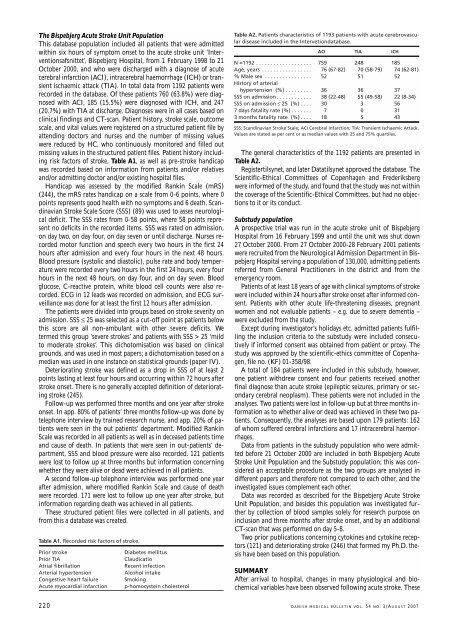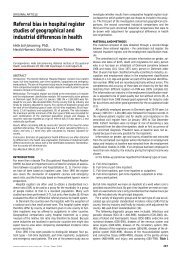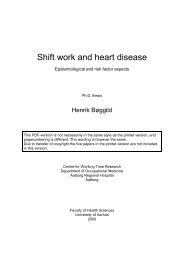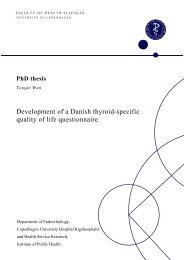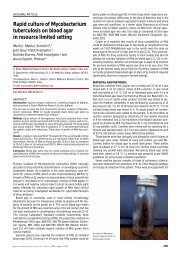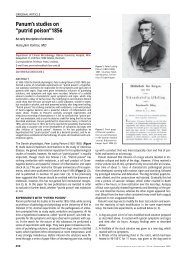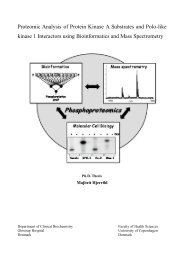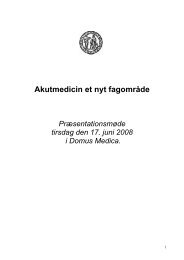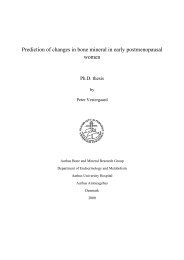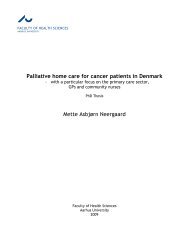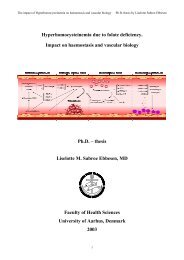Acute stroke â a dynamic process - Danish Medical Bulletin
Acute stroke â a dynamic process - Danish Medical Bulletin
Acute stroke â a dynamic process - Danish Medical Bulletin
Create successful ePaper yourself
Turn your PDF publications into a flip-book with our unique Google optimized e-Paper software.
The Bispebjerg <strong>Acute</strong> Stroke Unit Population<br />
This database population included all patients that were admitted<br />
within six hours of symptom onset to the acute <strong>stroke</strong> unit ‘Interventionsafsnittet’,<br />
Bispebjerg Hospital, from 1 February 1998 to 21<br />
October 2000, and who were discharged with a diagnose of acute<br />
cerebral infarction (ACI), intracerebral haemorrhage (ICH) or transient<br />
ischaemic attack (TIA). In total data from 1192 patients were<br />
recorded in the database. Of these patients 760 (63.8%) were diagnosed<br />
with ACI, 185 (15.5%) were diagnosed with ICH, and 247<br />
(20.7%) with TIA at discharge. Diagnoses were in all cases based on<br />
clinical findings and CT-scan. Patient history, <strong>stroke</strong> scale, outcome<br />
scale, and vital values were registered on a structured patient file by<br />
attending doctors and nurses and the number of missing values<br />
were reduced by HC, who continuously monitored and filled out<br />
missing values in the structured patient files. Patient history including<br />
risk factors of <strong>stroke</strong>, Table A1, as well as pre-<strong>stroke</strong> handicap<br />
was recorded based on information from patients and/or relatives<br />
and/or admitting doctor and/or existing hospital files.<br />
Handicap was assessed by the modified Rankin Scale (mRS)<br />
(244), the mRS rates handicap on a scale from 0-6 points, where 0<br />
points represents good health with no symptoms and 6 death. Scandinavian<br />
Stroke Scale Score (SSS) (89) was used to asses neurological<br />
deficit. The SSS rates from 0-58 points, where 58 points represent<br />
no deficits in the recorded items. SSS was rated on admission,<br />
on day two, on day four, on day seven or until discharge. Nurses recorded<br />
motor function and speech every two hours in the first 24<br />
hours after admission and every four hours in the next 48 hours.<br />
Blood pressure (systolic and diastolic), pulse rate and body temperature<br />
were recorded every two hours in the first 24 hours, every four<br />
hours in the next 48 hours, on day four, and on day seven. Blood<br />
glucose, C-reactive protein, white blood cell counts were also recorded.<br />
ECG in 12 leads was recorded on admission, and ECG surveillance<br />
was done for at least the first 12 hours after admission.<br />
The patients were divided into groups based on <strong>stroke</strong> severity on<br />
admission. SSS ≤ 25 was selected as a cut-off point as patients below<br />
this score are all non-ambulant with other severe deficits. We<br />
termed this group ‘severe <strong>stroke</strong>s’ and patients with SSS > 25 ‘mild<br />
to moderate <strong>stroke</strong>s’. This dichotomisation was based on clinical<br />
grounds, and was used in most papers; a dichotomisation based on a<br />
median was used in one instance on statistical grounds (paper IV).<br />
Deteriorating <strong>stroke</strong> was defined as a drop in SSS of at least 2<br />
points lasting at least four hours and occurring within 72 hours after<br />
<strong>stroke</strong> onset. There is no generally accepted definition of deteriorating<br />
<strong>stroke</strong> (245).<br />
Follow-up was performed three months and one year after <strong>stroke</strong><br />
onset. In app. 80% of patients’ three months follow-up was done by<br />
telephone interview by trained research nurse, and app. 20% of patients<br />
were seen in the out patients’ department. Modified Rankin<br />
Scale was recorded in all patients as well as in deceased patients time<br />
and cause of death. In patients that were seen in out-patients’ department,<br />
SSS and blood pressure were also recorded. 121 patients<br />
were lost to follow up at three months but information concerning<br />
whether they were alive or dead were achieved in all patients.<br />
A second follow-up telephone interview was performed one year<br />
after admission, where modified Rankin Scale and cause of death<br />
were recorded. 171 were lost to follow up one year after <strong>stroke</strong>, but<br />
information regarding death was achieved in all patients.<br />
These structured patient files were collected in all patients, and<br />
from this a database was created.<br />
Table A1. Recorded risk factors of <strong>stroke</strong>.<br />
Prior <strong>stroke</strong><br />
Prior TIA<br />
Atrial fibrillation<br />
Arterial hypertension<br />
Congestive heart failure<br />
<strong>Acute</strong> myocardial infarction<br />
Diabetes mellitus<br />
Claudicatio<br />
Recent infection<br />
Alcohol intake<br />
Smoking<br />
p-homocystein cholesterol<br />
Table A2. Patients characteristics of 1193 patients with acute cerebrovascular<br />
disease included in the Intervetiondatabase.<br />
ACI TIA ICH<br />
N =1192 . . . . . . . . . . . . . . . . . . . 759 248 185<br />
Age, years . . . . . . . . . . . . . . . . . 76 (67-82) 70 (58-79) 74 (62-81)<br />
% Male sex . . . . . . . . . . . . . . . . 52 51 52<br />
History of arterial<br />
hypertension (%) . . . . . . . . . 36 36 37<br />
SSS on admission . . . . . . . . . . . . 38 (22-48) 55 (49-58) 22 (8-34)<br />
SSS on admission ≤ 25 (%) . . . . 30 3 56<br />
7 days fatality rate (%) . . . . . . . 7 0 31<br />
3 months fatality rate (%) . . . . 18 5 43<br />
SSS: Scandinavian Stroke Scale; ACI Cerebral Infarction; TIA: Transient Ischaemic Attack.<br />
Values are stated as per cent or as median values with 25 and 75% quartiles.<br />
The general characteristics of the 1192 patients are presented in<br />
Table A2.<br />
Registertilsynet, and later Datatilsynet approved the database. The<br />
Scientific-Ethical Committees of Copenhagen and Frederiksberg<br />
were informed of the study, and found that the study was not within<br />
the coverage of the Scientific-Ethical Committees, but had no objections<br />
to it or its conduct.<br />
Substudy population<br />
A prospective trial was run in the acute <strong>stroke</strong> unit of Bispebjerg<br />
Hospital from 16 February 1999 and until the unit was shut down<br />
27 October 2000. From 27 October 2000-28 February 2001 patients<br />
were recruited from the Neurological Admission Department in Bispebjerg<br />
Hospital serving a population of 130,000, admitting patients<br />
referred from General Practitioners in the district and from the<br />
emergency room.<br />
Patients of at least 18 years of age with clinical symptoms of <strong>stroke</strong><br />
were included within 24 hours after <strong>stroke</strong> onset after informed consent.<br />
Patients with other acute life-threatening diseases, pregnant<br />
women and not evaluable patients – e.g. due to severe dementia –<br />
were excluded from the study.<br />
Except during investigator’s holidays etc. admitted patients fulfilling<br />
the inclusion criteria to the substudy were included consecutively<br />
if informed consent was obtained from patient or proxy. The<br />
study was approved by the scientific-ethics committee of Copenhagen,<br />
file no. (KF) 01-358/98.<br />
A total of 184 patients were included in this substudy, however,<br />
one patient withdrew consent and four patients received another<br />
final diagnose than acute <strong>stroke</strong> (epileptic seizures, primary or secondary<br />
cerebral neoplasm). These patients were not included in the<br />
analyses. Two patients were lost in follow-up but at three months information<br />
as to whether alive or dead was achieved in these two patients.<br />
Consequently, the analyses are based upon 179 patients: 162<br />
of whom suffered cerebral infarctions and 17 intracerebral haemorrhages.<br />
Data from patients in the substudy population who were admitted<br />
before 21 October 2000 are included in both Bispebjerg <strong>Acute</strong><br />
Stroke Unit Population and the Substudy population; this was considered<br />
an acceptable procedure as the two groups are analysed in<br />
different papers and therefore not compared to each other, and the<br />
investigated issues complement each other.<br />
Data was recorded as described for the Bispebjerg <strong>Acute</strong> Stroke<br />
Unit Population, and besides this population was investigated further<br />
by collection of blood samples solely for research purpose on<br />
inclusion and three months after <strong>stroke</strong> onset, and by an additional<br />
CT-scan that was performed on day 5-8.<br />
Two prior publications concerning cytokines and cytokine receptors<br />
(121) and deteriorating <strong>stroke</strong> (246) that formed my Ph.D. thesis<br />
have been based on this population.<br />
SUMMARY<br />
After arrival to hospital, changes in many physiological and biochemical<br />
variables have been observed following acute <strong>stroke</strong>. These<br />
220 DANISH MEDICAL BULLETIN VOL. 54 NO. 3/AUGUST 2007


